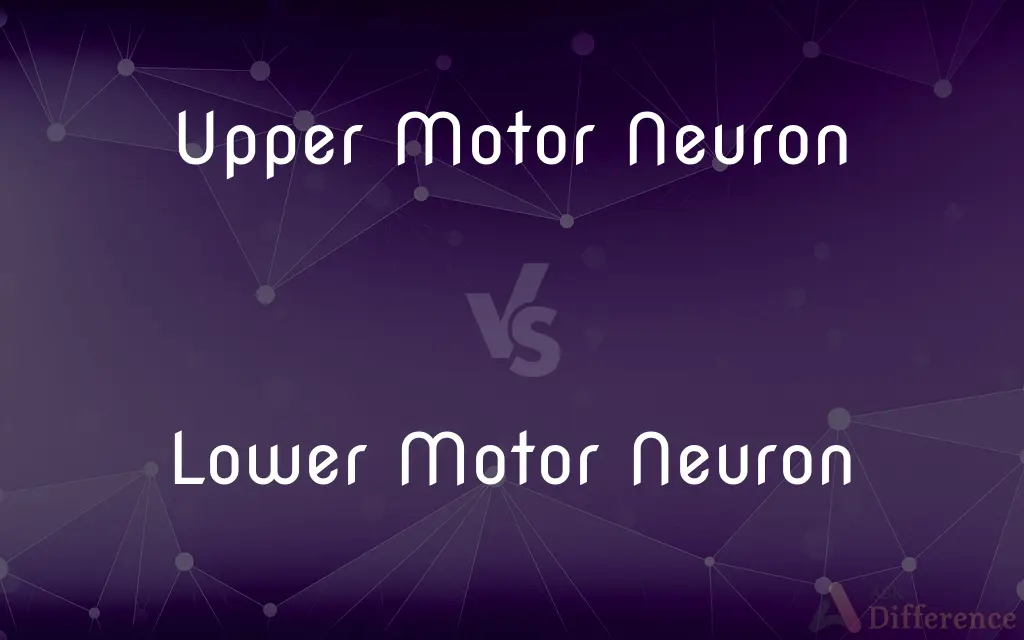Upper Motor Neuron vs. Lower Motor Neuron — What's the Difference?
Edited by Tayyaba Rehman — By Fiza Rafique — Published on December 8, 2023
Upper Motor Neurons originate in the brain and connect to the spinal cord, while Lower Motor Neurons connect the spinal cord to muscles. Both control voluntary muscle movements.

Difference Between Upper Motor Neuron and Lower Motor Neuron
Table of Contents
ADVERTISEMENT
Key Differences
Upper Motor Neurons (UMNs) have their cell bodies located within the central nervous system, specifically in the brain or brainstem. Their axons run within the central nervous system. In contrast, Lower Motor Neurons (LMNs) have their cell bodies in the spinal cord or brainstem, with axons extending to muscles.
UMNs play a significant role in initiating and controlling voluntary movements. They convey information from the brain to the spinal cord. Conversely, LMNs act as a bridge, conveying the signals from the spinal cord or brainstem directly to the muscles, resulting in muscle contraction and movement.
An injury or lesion to an Upper Motor Neuron often leads to symptoms such as spasticity, hyperreflexia, and muscle weakness without muscle atrophy. However, damage to a Lower Motor Neuron may result in flaccid paralysis, muscle atrophy, and decreased or absent reflexes.
The interaction between UMNs and LMNs is crucial for smooth, coordinated muscle movement. While the Upper Motor Neuron provides the primary signal and modulates the action, the Lower Motor Neuron serves as the final pathway, directly causing muscle activation.
In clinical practice, distinguishing between UMN and LMN lesions helps in diagnosis and treatment. While UMN lesions are typically associated with diseases like multiple sclerosis or stroke, LMN lesions can be seen in conditions like poliomyelitis or peripheral neuropathies.
ADVERTISEMENT
Comparison Chart
Location of Cell Bodies
Brain or brainstem
Spinal cord or brainstem
Connection
Connects brain to spinal cord
Connects spinal cord to muscles
Injury Symptoms
Spasticity, hyperreflexia, no muscle atrophy
Flaccid paralysis, muscle atrophy, decreased reflexes
Associated Diseases
Multiple sclerosis, stroke
Poliomyelitis, peripheral neuropathies
Primary Role
Initiates/modulates voluntary movement
Directly activates muscles
Compare with Definitions
Upper Motor Neuron
Upper Motor Neurons influence muscle tone and reflexes.
An Upper Motor Neuron lesion can heighten reflex response in a clinical examination.
Lower Motor Neuron
Lower Motor Neurons can be impacted in peripheral nerve injuries.
Traumatic injuries can damage the Lower Motor Neuron, leading to loss of muscle function.
Upper Motor Neuron
Upper Motor Neurons transmit signals from the brain to the spinal cord.
The Upper Motor Neuron plays a central role in voluntary movement initiation.
Lower Motor Neuron
Lower Motor Neurons control the final pathway to muscle activation.
Without the Lower Motor Neuron, a muscle cannot contract or function.
Upper Motor Neuron
Upper Motor Neurons can be affected in diseases like multiple sclerosis.
Multiple sclerosis often damages the Upper Motor Neuron, causing movement disorders.
Lower Motor Neuron
Lower Motor Neurons relay signals directly to muscles.
The Lower Motor Neuron's activation directly results in muscle contraction.
Upper Motor Neuron
Upper Motor Neurons reside within the central nervous system.
Damage to the Upper Motor Neuron can lead to spasticity in the affected limb.
Lower Motor Neuron
Lower Motor Neurons have their cell bodies in the spinal cord or brainstem.
Damage to the Lower Motor Neuron can lead to muscle atrophy in the affected region.
Upper Motor Neuron
Upper Motor Neurons modulate signals for voluntary movements.
Without the Upper Motor Neuron's input, movements would lack finesse and coordination.
Lower Motor Neuron
Lower Motor Neurons are responsible for muscle contraction and movement.
Each twitch of a muscle fiber is a direct response to a Lower Motor Neuron's signal.
Common Curiosities
How does Lower Motor Neuron damage manifest?
Damage can result in flaccid paralysis, muscle atrophy, and decreased or absent reflexes.
What is the primary role of an Upper Motor Neuron?
The Upper Motor Neuron initiates and modulates voluntary movements from the brain to the spinal cord.
What symptoms arise from Upper Motor Neuron damage?
Symptoms can include spasticity, hyperreflexia, and muscle weakness without atrophy.
Where are Upper Motor Neurons located?
They have cell bodies in the brain or brainstem, and their axons run within the central nervous system.
Are Lower Motor Neurons implicated in peripheral neuropathies?
Yes, conditions like peripheral neuropathies or poliomyelitis can affect Lower Motor Neurons.
Which diseases might affect Upper Motor Neurons?
Diseases like multiple sclerosis or stroke can impact Upper Motor Neurons.
What happens if the interaction between UMN and LMN is disrupted?
Disruption can lead to uncoordinated, weak, or inappropriate muscle activation.
Do Upper Motor Neurons directly control muscles?
No, Upper Motor Neurons modulate signals, while Lower Motor Neurons directly control muscles.
Do Upper Motor Neurons have a role in reflexes?
Yes, Upper Motor Neurons influence muscle tone and reflex modulation.
How does a Lower Motor Neuron function?
The Lower Motor Neuron conveys signals from the spinal cord or brainstem directly to the muscles, causing muscle contraction.
Where can you find Lower Motor Neurons?
Their cell bodies are in the spinal cord or brainstem, with axons extending to muscles.
Can trauma lead to Lower Motor Neuron damage?
Yes, traumatic injuries can damage Lower Motor Neurons, affecting muscle function.
Why is it important to distinguish between UMN and LMN lesions?
Distinguishing helps in accurate diagnosis, understanding the disease process, and deciding treatment approaches.
Is muscle atrophy a sign of Upper Motor Neuron damage?
Not typically. Muscle atrophy is more indicative of Lower Motor Neuron damage.
Can diseases affect both Upper and Lower Motor Neurons simultaneously?
Yes, certain diseases like amyotrophic lateral sclerosis (ALS) can affect both types of motor neurons.
Share Your Discovery

Previous Comparison
501a vs. 502a
Next Comparison
Substitutional Alloys vs. Interstitial AlloysAuthor Spotlight
Written by
Fiza RafiqueFiza Rafique is a skilled content writer at AskDifference.com, where she meticulously refines and enhances written pieces. Drawing from her vast editorial expertise, Fiza ensures clarity, accuracy, and precision in every article. Passionate about language, she continually seeks to elevate the quality of content for readers worldwide.
Edited by
Tayyaba RehmanTayyaba Rehman is a distinguished writer, currently serving as a primary contributor to askdifference.com. As a researcher in semantics and etymology, Tayyaba's passion for the complexity of languages and their distinctions has found a perfect home on the platform. Tayyaba delves into the intricacies of language, distinguishing between commonly confused words and phrases, thereby providing clarity for readers worldwide.










































